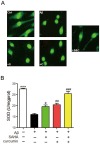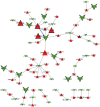The anti-tumor histone deacetylase inhibitor SAHA and the natural flavonoid curcumin exhibit synergistic neuroprotection against amyloid-beta toxicity
- PMID: 24409332
- PMCID: PMC3883700
- DOI: 10.1371/journal.pone.0085570
The anti-tumor histone deacetylase inhibitor SAHA and the natural flavonoid curcumin exhibit synergistic neuroprotection against amyloid-beta toxicity
Abstract
With the trend of an increasing aged population worldwide, Alzheimer's disease (AD), an age-related neurodegenerative disorder, as one of the major causes of dementia in elderly people is of growing concern. Despite the many hard efforts attempted during the past several decades in trying to elucidate the pathological mechanisms underlying AD and putting forward potential therapeutic strategies, there is still a lack of effective treatments for AD. The efficacy of many potential therapeutic drugs for AD is of main concern in clinical practice. For example, large bodies of evidence show that the anti-tumor histone deacetylase (HDAC) inhibitor, suberoylanilidehydroxamic acid (SAHA), may be of benefit for the treatment of AD; however, its extensive inhibition of HDACs makes it a poor therapeutic. Moreover, the natural flavonoid, curcumin, may also have a potential therapeutic benefit against AD; however, it is plagued by low bioavailability. Therefore, the integrative effects of SAHA and curcumin were investigated as a protection against amyloid-beta neurotoxicity in vitro. We hypothesized that at low doses their synergistic effect would improve therapeutic selectivity, based on experiments that showed that at low concentrations SAHA and curcumin could provide comprehensive protection against Aβ25-35-induced neuronal damage in PC12 cells, strongly implying potent synergism. Furthermore, network analysis suggested that the possible mechanism underlying their synergistic action might be derived from restoration of the damaged functional link between Akt and the CBP/p300 pathway, which plays a crucial role in the pathological development of AD. Thus, our findings provided a feasible avenue for the application of a synergistic drug combination, SAHA and curcumin, in the treatment of AD.
Conflict of interest statement
Figures









Similar articles
-
Valproic acid attenuates Aβ25-35-induced neurotoxicity in PC12 cells through suppression of mitochondria-mediated apoptotic pathway.Biomed Pharmacother. 2018 Oct;106:77-82. doi: 10.1016/j.biopha.2018.06.080. Epub 2018 Jun 26. Biomed Pharmacother. 2018. PMID: 29957469
-
Synergistic Combination of Histone Deacetylase Inhibitor Suberoylanilide Hydroxamic Acid and Natural Flavonoid Curcumin Exhibits Anticancer and Antibacterial Activity.Anticancer Agents Med Chem. 2021;21(10):1301-1308. doi: 10.2174/1871520620666201006141317. Anticancer Agents Med Chem. 2021. PMID: 33023457
-
Suppression of lncRNA-ATB prevents amyloid-β-induced neurotoxicity in PC12 cells via regulating miR-200/ZNF217 axis.Biomed Pharmacother. 2018 Dec;108:707-715. doi: 10.1016/j.biopha.2018.08.155. Epub 2018 Sep 21. Biomed Pharmacother. 2018. PMID: 30248538
-
Synthetic Curcumin Analogs as Inhibitors of β -Amyloid Peptide Aggregation: Potential Therapeutic and Diagnostic Agents for Alzheimer's Disease.Mini Rev Med Chem. 2015;15(13):1110-21. doi: 10.2174/138955751513150923101841. Mini Rev Med Chem. 2015. PMID: 26420724 Review.
-
Protective Effects of Indian Spice Curcumin Against Amyloid-β in Alzheimer's Disease.J Alzheimers Dis. 2018;61(3):843-866. doi: 10.3233/JAD-170512. J Alzheimers Dis. 2018. PMID: 29332042 Free PMC article. Review.
Cited by
-
Role of histone deacetylase inhibitors in non-neoplastic diseases.Heliyon. 2024 Jul 2;10(13):e33997. doi: 10.1016/j.heliyon.2024.e33997. eCollection 2024 Jul 15. Heliyon. 2024. PMID: 39071622 Free PMC article. Review.
-
A combination of curcumin, vorinostat and silibinin reverses Aβ-induced nerve cell toxicity via activation of AKT-MDM2-p53 pathway.PeerJ. 2019 Apr 26;7:e6716. doi: 10.7717/peerj.6716. eCollection 2019. PeerJ. 2019. PMID: 31086728 Free PMC article.
-
"Curcumin, the King of Spices": Epigenetic Regulatory Mechanisms in the Prevention of Cancer, Neurological, and Inflammatory Diseases.Curr Pharmacol Rep. 2015 Apr;1(2):129-139. doi: 10.1007/s40495-015-0018-x. Epub 2015 Jan 30. Curr Pharmacol Rep. 2015. PMID: 26457241 Free PMC article.
-
PI3K Signaling in Neurons: A Central Node for the Control of Multiple Functions.Int J Mol Sci. 2018 Nov 23;19(12):3725. doi: 10.3390/ijms19123725. Int J Mol Sci. 2018. PMID: 30477115 Free PMC article. Review.
-
Neuroinflammation regulates the balance between hippocampal neuron death and neurogenesis in an ex vivo model of thiamine deficiency.J Neuroinflammation. 2022 Nov 14;19(1):272. doi: 10.1186/s12974-022-02624-6. J Neuroinflammation. 2022. PMID: 36376954 Free PMC article.
References
-
- Hardy JA, Higgins GA (1992) Alzheimer's disease: the amyloid cascade hypothesis. Science 256: 184–185. - PubMed
-
- Yamaguchi H, Ishiguro K, Uchida T, Takashima A, Lemere CA, et al. (1996) Preferential labeling of Alzheimer neurofibrillary tangles with antisera for tau protein kinase (TPK) I/glycogen synthase kinase-3 beta and cyclin-dependent kinase 5, a component of TPK II. Acta Neuropathol 92: 232–241. - PubMed
-
- Karran E, Mercken M, De Strooper B (2011) The amyloid cascade hypothesis for Alzheimer's disease: an appraisal for the development of therapeutics. Nat Rev Drug Discov 10: 698–712. - PubMed
Publication types
MeSH terms
Substances
LinkOut - more resources
Full Text Sources
Other Literature Sources
Miscellaneous

